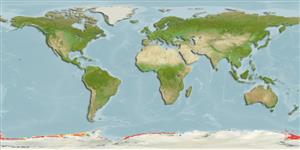>
Perciformes/Notothenioidei (Icefishes) >
Artedidraconidae (Barbled plunderfishes)
Etymology: Artedidraco: Petrus (Peter) Artedi, (10 Mar.) 1705-35 (28 Sep.), a son of a clergyman from Anundsjö named Olaus Arctaedius, in the northern part of Sweden.In 1729 he changed his name from Arctaedius to Arctædi, a name still later simplified to Artedi (Ref. 45335).
Eponymy: Oriana Fanny Wilson, née Souper (ca: 1874–1945) was an English naturalist and humanitarian; the wife of English polar explorer Edward Adrian Wilson (q. [...] (Ref. 128868), visit book page.
More on author: Regan.
Environment: milieu / climate zone / depth range / distribution range
Écologie
marin démersal; profondeur 82 - 801 m. Polar; 66°S - 77°S
Southern Ocean: East Antarctica (Ross Sea, South Victoria Land, Weddell Sea).
Taille / Poids / Âge
Maturity: Lm ? range ? - ? cm
Max length : 15.2 cm TL mâle / non sexé; (Ref. 124149); 16.7 cm TL (female); poids max. publié: 38.00 g (Ref. 124149); poids max. publié: 38.00 g
Found on the sublittoral and continental shelf. Feeds mainly on gammaridean amphipods, with substantial amounts of errant polychaetes. Isopods were a minor food item.
Life cycle and mating behavior
Maturité | Reproduction | Frai | Œufs | Fécondité | Larves
Eakin, R.R., 1990. Artedidraconidae. p. 332-356. In O. Gon and P.C. Heemstra (eds.) Fishes of the Southern Ocean. J.L.B. Smith Institute of Ichthyology, Grahamstown, South Africa. (Ref. 5181)
Statut dans la liste rouge de l'IUCN (Ref. 130435: Version 2024-2)
Menace pour l'homme
Harmless
Utilisations par l'homme
Pêcheries: sans intérêt
Outils
Articles particuliers
Télécharger en XML
Sources Internet
Estimates based on models
Preferred temperature (Ref.
123201): -1.8 - 0.3, mean -1 °C (based on 290 cells).
Phylogenetic diversity index (Ref.
82804): PD
50 = 0.5156 [Uniqueness, from 0.5 = low to 2.0 = high].
Bayesian length-weight: a=0.00537 (0.00342 - 0.00843), b=3.27 (3.13 - 3.41), in cm total length, based on LWR estimates for this species & (Sub)family-body (Ref.
93245).
Niveau trophique (Ref.
69278): 3.2 ±0.45 se; based on food items.
Résilience (Ref.
120179): Milieu, temps minimum de doublement de population : 1,4 à 4,4 années (Assuming fec > 100).
Fishing Vulnerability (Ref.
59153): Low vulnerability (10 of 100).
